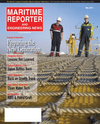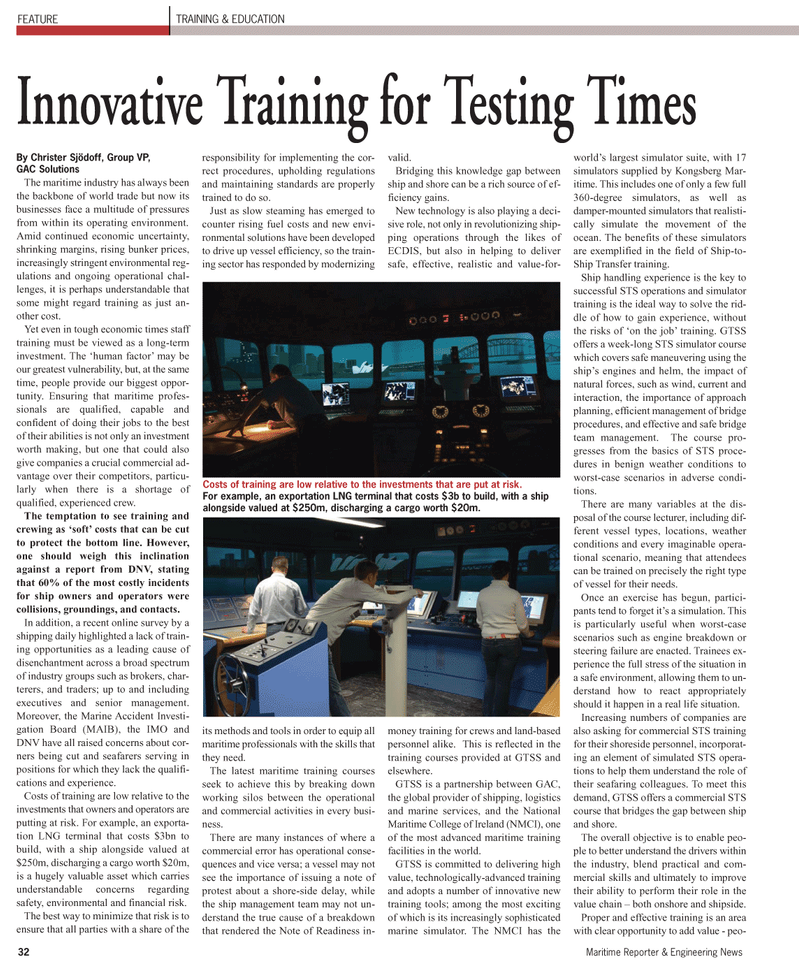
Page 32: of Maritime Reporter Magazine (May 2011)
Training & Education Edition
Read this page in Pdf, Flash or Html5 edition of May 2011 Maritime Reporter Magazine
By Christer Sjödoff, Group VP,
GAC Solutions
The maritime industry has always been the backbone of world trade but now its businesses face a multitude of pressures from within its operating environment.
Amid continued economic uncertainty, shrinking margins, rising bunker prices, increasingly stringent environmental reg- ulations and ongoing operational chal- lenges, it is perhaps understandable that some might regard training as just an- other cost.
Yet even in tough economic times staff training must be viewed as a long-term investment. The ‘human factor’ may be our greatest vulnerability, but, at the same time, people provide our biggest oppor- tunity. Ensuring that maritime profes- sionals are qualified, capable and confident of doing their jobs to the best of their abilities is not only an investment worth making, but one that could also give companies a crucial commercial ad- vantage over their competitors, particu- larly when there is a shortage of qualified, experienced crew.
The temptation to see training and crewing as ‘soft’ costs that can be cut to protect the bottom line. However, one should weigh this inclination against a report from DNV, stating that 60% of the most costly incidents for ship owners and operators were collisions, groundings, and contacts.
In addition, a recent online survey by a shipping daily highlighted a lack of train- ing opportunities as a leading cause of disenchantment across a broad spectrum of industry groups such as brokers, char- terers, and traders; up to and including executives and senior management.
Moreover, the Marine Accident Investi- gation Board (MAIB), the IMO and
DNV have all raised concerns about cor- ners being cut and seafarers serving in positions for which they lack the qualifi- cations and experience.
Costs of training are low relative to the investments that owners and operators are putting at risk. For example, an exporta- tion LNG terminal that costs $3bn to build, with a ship alongside valued at $250m, discharging a cargo worth $20m, is a hugely valuable asset which carries understandable concerns regarding safety, environmental and financial risk.
The best way to minimize that risk is to ensure that all parties with a share of the responsibility for implementing the cor- rect procedures, upholding regulations and maintaining standards are properly trained to do so.
Just as slow steaming has emerged to counter rising fuel costs and new envi- ronmental solutions have been developed to drive up vessel efficiency, so the train- ing sector has responded by modernizing its methods and tools in order to equip all maritime professionals with the skills that they need.
The latest maritime training courses seek to achieve this by breaking down working silos between the operational and commercial activities in every busi- ness.
There are many instances of where a commercial error has operational conse- quences and vice versa; a vessel may not see the importance of issuing a note of protest about a shore-side delay, while the ship management team may not un- derstand the true cause of a breakdown that rendered the Note of Readiness in- valid.
Bridging this knowledge gap between ship and shore can be a rich source of ef- ficiency gains.
New technology is also playing a deci- sive role, not only in revolutionizing ship- ping operations through the likes of
ECDIS, but also in helping to deliver safe, effective, realistic and value-for- money training for crews and land-based personnel alike. This is reflected in the training courses provided at GTSS and elsewhere.
GTSS is a partnership between GAC, the global provider of shipping, logistics and marine services, and the National
Maritime College of Ireland (NMCI), one of the most advanced maritime training facilities in the world.
GTSS is committed to delivering high value, technologically-advanced training and adopts a number of innovative new training tools; among the most exciting of which is its increasingly sophisticated marine simulator. The NMCI has the world’s largest simulator suite, with 17 simulators supplied by Kongsberg Mar- itime. This includes one of only a few full 360-degree simulators, as well as damper-mounted simulators that realisti- cally simulate the movement of the ocean. The benefits of these simulators are exemplified in the field of Ship-to-
Ship Transfer training.
Ship handling experience is the key to successful STS operations and simulator training is the ideal way to solve the rid- dle of how to gain experience, without the risks of ‘on the job’ training. GTSS offers a week-long STS simulator course which covers safe maneuvering using the ship’s engines and helm, the impact of natural forces, such as wind, current and interaction, the importance of approach planning, efficient management of bridge procedures, and effective and safe bridge team management. The course pro- gresses from the basics of STS proce- dures in benign weather conditions to worst-case scenarios in adverse condi- tions.
There are many variables at the dis- posal of the course lecturer, including dif- ferent vessel types, locations, weather conditions and every imaginable opera- tional scenario, meaning that attendees can be trained on precisely the right type of vessel for their needs.
Once an exercise has begun, partici- pants tend to forget it’s a simulation. This is particularly useful when worst-case scenarios such as engine breakdown or steering failure are enacted. Trainees ex- perience the full stress of the situation in a safe environment, allowing them to un- derstand how to react appropriately should it happen in a real life situation.
Increasing numbers of companies are also asking for commercial STS training for their shoreside personnel, incorporat- ing an element of simulated STS opera- tions to help them understand the role of their seafaring colleagues. To meet this demand, GTSS offers a commercial STS course that bridges the gap between ship and shore.
The overall objective is to enable peo- ple to better understand the drivers within the industry, blend practical and com- mercial skills and ultimately to improve their ability to perform their role in the value chain – both onshore and shipside.
Proper and effective training is an area with clear opportunity to add value - peo- 32 Maritime Reporter & Engineering News
FEATURE TRAINING & EDUCATION
Innovative Training for Testing Times
Costs of training are low relative to the investments that are put at risk.
For example, an exportation LNG terminal that costs $3b to build, with a ship alongside valued at $250m, discharging a cargo worth $20m.

 31
31

 33
33
